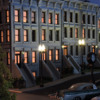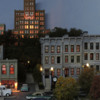Woodland products in the 'plug and play' line will not take 12-16 AC........I tried 12 DC and burned up 3 in seconds.
Is this statement correct? It could be but seems screwy.
Your trailing example only refers to 12v DC where the main subject is AC 12-15v. The reference at over 12v is mostly unfounded unless you ran long enough to make use of AC's "cooling time" as an incandecent lamp cools on ac cycles. If LED?, well are mosy just very sensative to overvoltage.
Most cooked led are from our old school low voltage habits of maxing voltages for a split second to "test" or brighten; or from using ac. A diode uses DC by nature. Any diode that seems to run on ac is one of a rare breed, and/or has a limited lifespan or is regulated/rectified "somewhere" "unkown", but usually as add on components like another diode(s),resistors, etc.
Without an LED I.D. to know what to use, test with power from a source to match up to of a few amps (enough for one or for a string, more amps are better) use DC at 1.5v then 3v then 4.5 then 6v then 9v then 12v. ,16v, 24v,32v,etc Stop at the lowest voltage where you get about the expected brightness (a guess and remember overvoltage will cook it) dim if needed with more resistance. A 3v LED at 2.9v DC doesn't care if a button cell battery or a 10amp dc power supply is feeding it, just never more than three volt. It is likely brightly lit at well under 2v. If you give it 3.5v it cooks is seconds. (It's a good idea to use some resistance as some modern power supplies might need some to see a decent enough draw to want to do any work at all. The amount of power a low volt led actually uses is "stupid small".  )
)
As far as "plug and play" goes; the term has been regretably twisted to become a quiet proprietary term vs the "generic" usability it's use once implied. To me plug and play would mean accepting up to 18v ac.. actually it should take short bursts of 25vac imo, but I've lowered my expectations some just for modern comparative considerations on power.
It may as well be labeled great, bargan, value, best, or deal of the century  .
.
John, it looks great but I can draw at least three pictures with that "simple/easy" explanation. More depending on if "linker plug and connector plug" are the same thing (changing terminology never helps) and more for whatever my imagination might think push button repticals might be ... Are they a female plug that a button plugs into? Are they a recptical on a push button unit. Is that unit the same as the grey box? Is the grey box a hub? Are the buttons a hub? Slightly exaggerating the confusion, and theretisiappreciation but I want to say... "Those that can, shouldn't necessarily teach" 





















